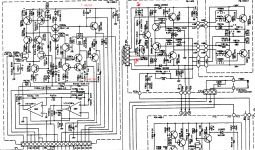I'm rebuilding the main Amp. of a Luxman-550 with new components, and want to make sure that I get the bias current right.
I have replaced the STV-2H with two 1N4001 diodes in series, but I don't know the specs for the thermistor TH801 that is put in parallel over the R802, see the uploaded schematics.
So to make sure I get things right, I want to recalculate the resistors making the bias current.
My problem is that I cannot figure out what the voltage drop is over these resistors (as indicated on the uploaded schematic). Can anyone help me?
I have replaced the STV-2H with two 1N4001 diodes in series, but I don't know the specs for the thermistor TH801 that is put in parallel over the R802, see the uploaded schematics.
So to make sure I get things right, I want to recalculate the resistors making the bias current.
My problem is that I cannot figure out what the voltage drop is over these resistors (as indicated on the uploaded schematic). Can anyone help me?
Attachments
You can't calculate the resistance required, just reset the trimmer for the correct bias current. The volt drop across your two new diodes will be very different to the original part... not in itself an issue, just readjust the bias.,
You can't calculate the resistance required, just reset the trimmer for the correct bias current. The volt drop across your two new diodes will be very different to the original part... not in itself an issue, just readjust the bias.,
Just wanted to be sure that the trimmer still works within the right range before powering up. I guess replacing the STV-2H with a LED would certainly require a recalculation of the resistors due to difference in voltage drop.
Lampie, That is not true at all. Where did you hear that silliness anyway?
Eldoctore, why are you replacing that bias diode in the first place? They only fail when ham-handed people break the leads off. Put them back in and your amplifier will bias properly as it was designed.
I was authorized Luxman warranty for many years and have been servicing equipment for over 45 years now. That bias diode assembly was designed to have good thermal contact. In the event one is broken, you would replace it with a pair of 1N4148 or 1N914 signal diodes (low thermal mass). That circuit does not carry high current at all. The power diodes you are using have lower voltage drop because the junction is a lot larger than the original or signal diodes.
So for a good rebuild, continue using the proper bias diode. The engineers used it for a reason as they had access to cheaper signal diodes back then. So obviously they used that much more expensive bias diode for a reason. Don't second guess the trained engineers that designed good audio equipment. They knew what they were doing. Arm chair designers are idiots by comparison.
-Chris
Eldoctore, why are you replacing that bias diode in the first place? They only fail when ham-handed people break the leads off. Put them back in and your amplifier will bias properly as it was designed.
I was authorized Luxman warranty for many years and have been servicing equipment for over 45 years now. That bias diode assembly was designed to have good thermal contact. In the event one is broken, you would replace it with a pair of 1N4148 or 1N914 signal diodes (low thermal mass). That circuit does not carry high current at all. The power diodes you are using have lower voltage drop because the junction is a lot larger than the original or signal diodes.
So for a good rebuild, continue using the proper bias diode. The engineers used it for a reason as they had access to cheaper signal diodes back then. So obviously they used that much more expensive bias diode for a reason. Don't second guess the trained engineers that designed good audio equipment. They knew what they were doing. Arm chair designers are idiots by comparison.
-Chris
Just wanted to be sure that the trimmer still works within the right range before powering up.
Always use a bulb tester... it will save excess current scenarios that would be damaging.
- Home
- Amplifiers
- Solid State
- Luxman 550 rebuild project - calculating the bias current
